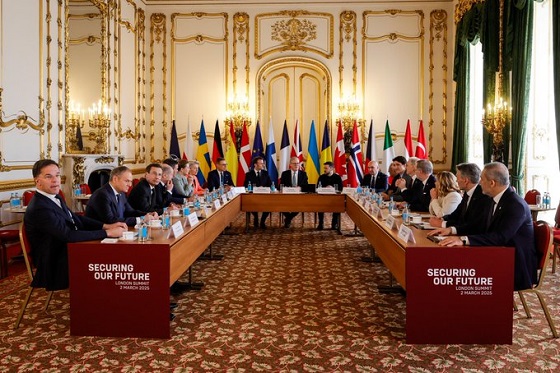conflict
Europe moves to broker Ukraine peace deal, seeks Trump’s backing

 MxM News
MxM News
Quick Hit:
The United Kingdom, France, and Ukraine are working on a ceasefire proposal to end the Russia-Ukraine war, aiming to present the plan to President Donald Trump. The move follows a tense Oval Office meeting that has strained U.S.-Ukraine relations.
Key Details:
- British Prime Minister Keir Starmer and French President Emmanuel Macron are leading efforts to mediate a Ukraine peace deal, with Italy also signaling interest.
- The plan involves a ceasefire, European-led security guarantees, and a “coalition of the willing” to stabilize Ukraine post-conflict.
- Trump remains skeptical of long-term U.S. security commitments, making European efforts critical to any peace deal’s success.
Diving Deeper:
Following an explosive Oval Office exchange between President Donald Trump, Vice President JD Vance, and Ukrainian President Volodymyr Zelensky, European leaders have intensified their efforts to mediate an end to the war in Ukraine. The U.K. and France have taken the lead in drafting a ceasefire plan, with Prime Minister Keir Starmer emphasizing that a “coalition of the willing” must act swiftly to bring an end to the bloody three-year conflict.
In a Sunday interview with the BBC, Starmer confirmed that the U.K., France, and Ukraine had agreed to begin formal negotiations on a peace plan, which they would later present to Washington. Italian Prime Minister Giorgia Meloni also expressed interest in playing a role, hinting at a broader European effort to push for a settlement.
However, Europe’s diplomatic push faces major obstacles. The proposal reportedly includes European peacekeeping troops in Ukraine—something Russia has flatly rejected. Russian Foreign Minister Sergei Lavrov called the idea “unacceptable,” accusing European nations, particularly France and the U.K., of fueling the war instead of ending it.
Further complicating matters, Starmer stressed that the plan should include a U.S. security guarantee for Ukraine—an idea Trump has repeatedly dismissed. At his first Cabinet meeting, Trump made it clear that Europe should take the lead, stating, “I’m not going to make security guarantees beyond very much. We’re going to have Europe do that.”
Zelensky’s insistence on American security commitments during Friday’s meeting reportedly led to the breakdown in talks, with Trump removing him from the White House and stating that the Ukrainian leader “can come back when he is ready for peace.” In response, European officials rallied around Zelensky, with German Foreign Minister Annalena Baerbock calling the White House exchange “horrifying” and the European Union’s top diplomat, Kaja Kallas, suggesting that the “free world needs a new leader.”
While Europe’s push for a peace plan may help Zelensky demonstrate openness to negotiations, its chances of success remain uncertain. Without Trump’s backing or Russian agreement, the proposal risks becoming another diplomatic exercise with little impact on the battlefield. Furthermore, if European nations wish to replace the U.S. as Ukraine’s primary security guarantor, they will need to significantly increase their defense spending—something unlikely given their entrenched welfare commitments.
For now, European leaders appear eager to test Trump’s willingness to engage in peace efforts on their terms. Whether he accepts their proposal, or insists on his own approach, could define the next phase of the war.
Artificial Intelligence
AI Drone ‘Swarms’ Unleashed On Ukraine Battlefields, Marking New Era Of Warfare


From the Daily Caller News Foundation
Artificial intelligence-powered drones are making their first appearances on the battlefield in the Russia-Ukraine war as warfare creeps closer to full automation.
In bombardments on Russian targets in the past year, Ukrainian drones acting in concert were able to independently determine where to strike without human input.
It’s the first battlefield use of AI “swarm” technology in a real-world environment, a senior Ukrainian official and Swarmer, the company who makes the software, told the Wall Street Journal in a Tuesday report. While drones have increasingly defined modern battlefields, swarms until now had been confined to testing rather than combat.
“You set the target and the drones do the rest,” Swarmer Chief Executive Serhii Kupriienko told the WSJ. “They work together, they adapt.”
So far, the Swarmer technology has been used hundreds of times to target Russia assets, but was first used a year ago to lay mines on the front, the Ukrainian official told the WSJ. The software has been tested with up to 25 drones at once, but is usually utilized with only three.
Kupriienko told the WSJ that he was preparing to test up to 100 drones at once with the linking software.
A common arrangement used on the battlefield includes one reconnaissance drone to scout out the target and two explosive drones delivering the payload on target, the official told the WSJ.
While Western nations such as the U.S., France and the United Kingdom are also pursuing drone swarm technology, they have not deployed swarm technology on the battlefield the way Ukraine has, according to the WSJ. Currently, autonomous weapons are not regulated by any international authority or binding agreement, but ethical concerns around the technology has led many to call for increased regulation of weapons like the Swarmer system.
The Ukrainian Ministry of Foreign Affairs did not immediately respond to the Daily Caller News Foundation’s request for comment.
conflict
Trump Pentagon Reportedly Blocking Ukraine From Firing Western Missiles Deep Into Russia


From the Daily Caller News Foundation
The Department of Defense has spent months blocking the Ukrainian military from using American and British-made missiles to hit targets deep inside Russia, The Wall Street Journal reported Sunday, citing unnamed U.S. officials.
Undersecretary of Defense for Policy Eldridge Colby reportedly designed the procedure to review requests to carry out the long-range strikes with weapons that are either of U.S. origin or that require American intelligence or use components provided by the U.S., according to the WSJ. Secretary of Defense Pete Hegseth reportedly has the final say on whether Ukrainian forces can use the MGM-140 ATACMS (Army Tactical Missile System) to hit targets in Russia.
The reported blocks on missile strikes coincides with a Trump administration effort to broker a peace deal between Russia and Ukraine. A Pentagon spokesperson declined to comment further on the matter.
BREAKING: President Vladimir Putin reacts to B-2 Flyover pic.twitter.com/1mzVn7DxlW
— Jack Poso 🇺🇸 (@JackPosobiec) August 15, 2025
The Biden administration allowed Ukraine to carry out strikes with ATACMS in November, weeks after President Donald Trump won the 2024 election, the New York Times reported. Trump criticized the move during a December interview with Time magazine.
“It’s crazy what’s taking place. It’s crazy,” Trump said. “I disagree very vehemently with sending missiles hundreds of miles into Russia. Why are we doing that? We’re just escalating this war and making it worse. That should not have been allowed to be done.”
Trump and Russian President Vladimir Putin met in Alaska on Aug. 15 for a summit meeting during which Trump sought to secure a cease-fire in Russia’s war with Ukraine. As Trump greeted Putin, a B-2A Spirit stealth bomber and several fighters carried out a flyover of Elmendorf Air Force Base.
Trump met with Ukrainian President Volodymyr Zelensky and major European leaders on Aug. 18 to update them on the summit.
In July, Trump reached an agreement with NATO where members of the alliance would purchase weapons, including MIM-104 Patriot surface-to-air missiles, and donate them to Ukraine.
-

 Crime2 days ago
Crime2 days agoPublic Execution of Anti-Cartel Mayor in Michoacán Prompts U.S. Offer to Intervene Against Cartels
-

 Environment2 days ago
Environment2 days agoThe era of Climate Change Alarmism is over
-

 Justice2 days ago
Justice2 days agoA Justice System That Hates Punishment Can’t Protect the Innocent
-

 Aristotle Foundation2 days ago
Aristotle Foundation2 days agoB.C. government laid groundwork for turning private property into Aboriginal land
-

 Business1 day ago
Business1 day agoCarney government should retire misleading ‘G7’ talking point on economic growth
-

 Daily Caller1 day ago
Daily Caller1 day agoNigeria Would Welcome US Intervention In Massacre Of Christians By Islamic Terror Groups
-

 Alberta1 day ago
Alberta1 day agoCanada’s heavy oil finds new fans as global demand rises
-

 Automotive1 day ago
Automotive1 day agoCanada’s EV experiment has FAILED






